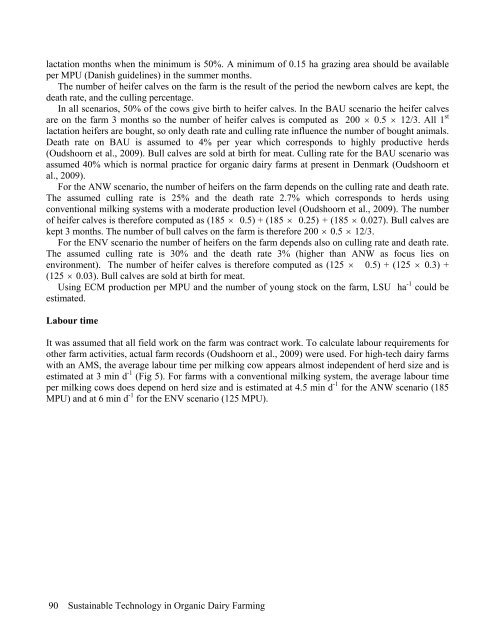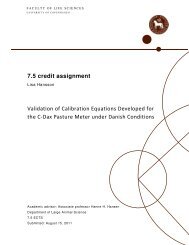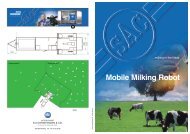Innovative Technology and Sustainable Development of Organic - 1.
Innovative Technology and Sustainable Development of Organic - 1.
Innovative Technology and Sustainable Development of Organic - 1.
Create successful ePaper yourself
Turn your PDF publications into a flip-book with our unique Google optimized e-Paper software.
lactation months when the minimum is 50%. A minimum <strong>of</strong> 0.15 ha grazing area should be available<br />
per MPU (Danish guidelines) in the summer months.<br />
The number <strong>of</strong> heifer calves on the farm is the result <strong>of</strong> the period the newborn calves are kept, the<br />
death rate, <strong>and</strong> the culling percentage.<br />
In all scenarios, 50% <strong>of</strong> the cows give birth to heifer calves. In the BAU scenario the heifer calves<br />
are on the farm 3 months so the number <strong>of</strong> heifer calves is computed as 200 � 0.5 � 12/3. All 1<br />
lactation heifers are bought, so only death rate <strong>and</strong> culling rate influence the number <strong>of</strong> bought animals.<br />
Death rate on BAU is assumed to 4% per year which corresponds to highly productive herds<br />
(Oudshoorn et al., 2009). Bull calves are sold at birth for meat. Culling rate for the BAU scenario was<br />
assumed 40% which is normal practice for organic dairy farms at present in Denmark (Oudshoorn et<br />
al., 2009).<br />
For the ANW scenario, the number <strong>of</strong> heifers on the farm depends on the culling rate <strong>and</strong> death rate.<br />
The assumed culling rate is 25% <strong>and</strong> the death rate 2.7% which corresponds to herds using<br />
conventional milking systems with a moderate production level (Oudshoorn et al., 2009). The number<br />
<strong>of</strong> heifer calves is therefore computed as (185 � 0.5) + (185 � 0.25) + (185 � 0.027). Bull calves are<br />
kept 3 months. The number <strong>of</strong> bull calves on the farm is therefore 200 � 0.5 � 12/3.<br />
For the ENV scenario the number <strong>of</strong> heifers on the farm depends also on culling rate <strong>and</strong> death rate.<br />
The assumed culling rate is 30% <strong>and</strong> the death rate 3% (higher than ANW as focus lies on<br />
environment). The number <strong>of</strong> heifer calves is therefore computed as (125 � 0.5) + (125 � 0.3) +<br />
(125 � 0.03). Bull calves are sold at birth for meat.<br />
Using ECM production per MPU <strong>and</strong> the number <strong>of</strong> young stock on the farm, LSU ha -1 could be<br />
estimated.<br />
Labour time<br />
It was assumed that all field work on the farm was contract work. To calculate labour requirements for<br />
other farm activities, actual farm records (Oudshoorn et al., 2009) were used. For high-tech dairy farms<br />
with an AMS, the average labour time per milking cow appears almost independent <strong>of</strong> herd size <strong>and</strong> is<br />
estimated at 3 min d -1 (Fig 5). For farms with a conventional milking system, the average labour time<br />
per milking cows does depend on herd size <strong>and</strong> is estimated at 4.5 min d -1 for the ANW scenario (185<br />
MPU) <strong>and</strong> at 6 min d -1 for the ENV scenario (125 MPU).<br />
90 <strong>Sustainable</strong> <strong>Technology</strong> in <strong>Organic</strong> Dairy Farming<br />
st




